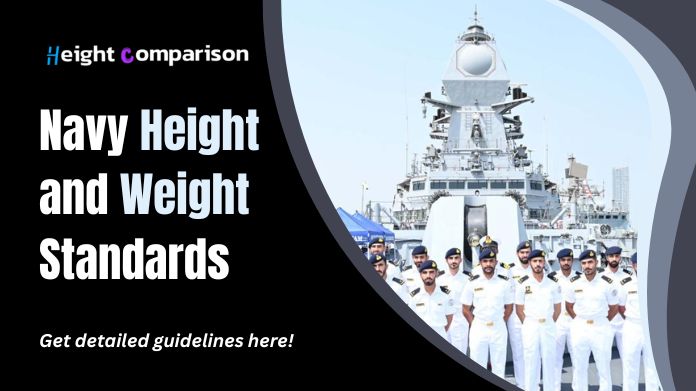Maintaining optimal height and weight standards is critical for naval personnel to ensure they are physically fit and prepared for their duties. As outlined in their standards, the Navy has specific Navy height and weight standards requirements that both male and female sailors must meet.
This Height Comparison guide will delve into the Navy height and weight standards, providing an overview and checking the charts for both males and females.
These standards concern appearance, functional fitness, and readiness for the demanding tasks naval personnel may face. By understanding and adhering to these standards, sailors can contribute to the Navy’s overall effectiveness and operational readiness.
Let’s explore the Navy height and weight standards to gain insights into the expectations for male and female sailors and the importance of maintaining physical fitness in the naval environment.
Navy Height and Weight Standards Chart

Here is the navy height and weight standards chart:
Males:
| Height (inches) | Minimum Weight (lbs) | Maximum Weight (lbs) |
|---|---|---|
| 62 | 127 | 160 |
| 63 | 131 | 165 |
| 64 | 136 | 170 |
| 65 | 141 | 175 |
| 66 | 145 | 181 |
| 67 | 150 | 186 |
| 68 | 155 | 192 |
| 69 | 160 | 197 |
| 70 | 165 | 203 |
| 71 | 170 | 209 |
| 72 | 175 | 214 |
| 73 | 180 | 220 |
| 74 | 185 | 226 |
| 75 | 190 | 232 |
| 76 | 195 | 238 |
| 77 | 201 | 244 |
| 78 | 206 | 250 |
| 79 | 212 | 256 |
| 80 | 218 | 263 |
Females:
| Height (inches) | Minimum Weight (lbs) | Maximum Weight (lbs) |
|---|---|---|
| 58 | 112 | 149 |
| 59 | 116 | 152 |
| 60 | 120 | 156 |
| 61 | 124 | 160 |
| 62 | 128 | 164 |
| 63 | 132 | 167 |
| 64 | 136 | 171 |
| 65 | 140 | 175 |
| 66 | 144 | 179 |
| 67 | 148 | 184 |
| 68 | 152 | 188 |
| 69 | 156 | 193 |
| 70 | 160 | 197 |
| 71 | 164 | 202 |
| 72 | 168 | 206 |
| 73 | 172 | 211 |
| 74 | 176 | 216 |
| 75 | 180 | 221 |
| 76 | 184 | 226 |
| 77 | 188 | 231 |
| 78 | 192 | 236 |
Note: These standards are based on the U.S. Navy’s Physical Readiness Program (PRP) and are subject to change. The Navy also has a body fat percentage limit of 26% for males and 36% for females. If a service member exceeds the maximum weight for their height but meets the body fat percentage limit, they may still be considered within standards.
What Are the Basic Navy Weight Requirements?
The United States Navy has established weight requirements to ensure that service members maintain a healthy body composition and are physically ready to perform their duties.
The primary Navy weight requirements are as follows:
Maximum Weight Limit
- The Navy sets maximum weight limits based on a service member’s height and gender.
- These limits are outlined in the Navy height and weight standards chart.
- If a service member exceeds the maximum weight for their height, they may be subject to additional body fat percentage assessments.
Body Fat Percentage Limit
- In addition to the weight limits, the Navy also has body fat percentage standards.
- Males must maintain a body fat percentage of 26% or less.
- Females must maintain a body fat percentage of 36% or less.
- If a service member exceeds the maximum weight for their height but meets the body fat percentage limit, they may still be considered within standards.
Physical Readiness Test (PRT)
- The Navy assesses service members’ physical fitness through the Physical Readiness Test (PRT).
- The PRT consists of push-ups, sit-ups, and a 1.5-mile run, with performance standards varying by age and gender.
- Failure to meet the PRT standards or exceeding body fat percentage limits may result in enrollment in a mandatory physical conditioning program.
Medical Exemptions
- Sometimes, a service member may be granted a medical waiver for exceeding weight or body fat percentage limits due to a medical condition.
- These waivers are evaluated case-by-case and require documentation from a medical professional.
Consequences of Not Meeting Standards:
- Service members who consistently fail to meet the Navy’s weight and body fat percentage standards may face administrative actions, including counseling, fitness program enrollment, and potentially separation from the service.
It’s important to note that these requirements are subject to change and may be updated periodically by the Navy. Service members are expected to maintain a healthy lifestyle, engage in regular physical activity, and adhere to the Navy’s fitness and grooming standards throughout their careers.
What Are Additional Navy Weight Requirements for Specific Jobs and Rank Levels?
In the Navy, specific job roles and rank levels may have additional weight requirements beyond the standard height and weight standards. These additional weight requirements are often related to particular job functions and operational needs.
Here are some examples:
1. Specialized Roles: Certain specialized roles within the Navy, such as divers, aviation personnel, or special operations forces, may have specific weight requirements due to the nature of their duties. For instance, divers must maintain a certain weight to ensure underwater buoyancy control.
2. Physical Fitness Standards: Some job roles, especially those in combat or physically demanding environments, may have stringent physical fitness standards, including weight requirements. These standards aim to ensure that personnel can meet the physical demands of their duties.
3. Rank Levels: In some cases, higher-ranking positions may have weight standards different from those of lower ranks. This differentiation may be based on the responsibilities associated with the rank and the expected level of physical fitness required for leadership roles.
4. Medical Considerations: Individual medical conditions or fitness assessments may also influence weight requirements for specific jobs. Navy medical professionals assess each sailor’s health and fitness to determine whether they meet the standards for their assigned roles.
Navy personnel must be aware of additional weight requirements specific to their job roles or rank levels. Adhering to these standards ensures that sailors can perform their duties effectively and contribute to the overall mission readiness of the Navy.
Individuals should consult their commanding officers or medical personnel for detailed information on job-specific weight requirements.
Final Note
Adhering to the Navy height and weight standards is fundamental for maintaining physical fitness and operational readiness among naval personnel. The standards outlined in the height and weight charts for both males and females reflect the Navy’s commitment to ensuring that sailors are in optimal health to perform their duties effectively.
Meeting these standards goes beyond appearance; it directly impacts an individual’s ability to handle the physical demands of their roles and contribute to mission success. Understanding the additional weight requirements for specific job roles and rank levels is crucial for sailors to excel in their respective positions.
By staying informed about these standards and striving to meet them, sailors demonstrate their dedication to service and readiness. Personnel must engage in regular physical fitness activities, maintain a healthy lifestyle, and seek guidance from medical professionals when necessary to effectively uphold these standards.
Maintaining physical fitness is a personal responsibility and a collective commitment to the Navy’s mission readiness and success.






